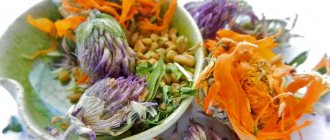The article was prepared by a specialist for informational purposes only. We urge you not to self-medicate. When the first symptoms appear, consult a doctor.
In Russia, tuberculosis became notorious as “consumption,” from the word “waste away.” And indeed, a person with tuberculosis wastes away before our eyes: he loses weight, turns pale, loses his appetite and suffers from coughing attacks. The culprit is a special mycobacterium, Koch's bacillus, which got its name from the name of the discoverer. Modern medicine has powerful antibiotics in its arsenal, but people have not yet been able to completely eradicate tuberculosis. Why?
Global climate change, as well as mutations of the pathogen itself, allow tuberculosis to survive, despite the efforts of doctors, and threaten people's health. It was previously believed that Koch's bacillus could only be picked up in places not so remote, but practice shows that becoming infected with tuberculosis is as easy as shelling pears. Today we will not discuss classical drug therapy, but will devote our conversation to traditional and alternative methods of treatment. Of course, qualified medical care is vital for pulmonary tuberculosis, but with the help of safe and time-tested means you can significantly speed up recovery and improve the patient’s well-being.
Pine pollen for tuberculosis
In any large public institution (at a train station, at a school, in a supermarket), the content of bacteria in the surrounding air does not fall below five thousand per 1 cubic meter, and more often goes off scale up to three hundred thousand. Here is the answer to the question why seasonal colds grow to epidemic proportions every year. Tuberculosis is also transmitted by airborne droplets, and although this pathogen is less common, there is still a danger.
For comparison, the air of a pine forest contains only about three hundred bacteria per 1 cubic meter! We can say that the atmosphere there is almost sterile, and also healing for health. Thanks for this we must say to phytoncides, natural antibiotics exuded by pine trees. And the essential oils contained in pine resin oxidize in the fresh air and fill it with pure ozone. That is why walks through the pine forest have been included by healers in the treatment program for pulmonary tuberculosis since ancient times.
If you live far from nature and do not have the opportunity to regularly breathe deeply the air of a pine forest, do not worry - you can collect and prepare pine pollen to treat tuberculosis at home all year round. All the healing power of pine is concentrated in this unique natural material, and recipes for preparing medicines based on pollen are very simple and accessible to everyone.
Composition and beneficial properties of pine pollen
Pine pollen is essentially a reproductive cell, so it is not surprising that nature has put a whole baggage of nutrients and useful substances into it:
- More than a dozen vitamins, including choline (250 mg/100 g). This substance accelerates cellular regeneration processes, protects the liver, improves blood quality - what could be more important for tuberculosis? Heavy doses of vitamins will support the patient’s health and help him cope with a severe chronic illness;
- Valuable micro- and macroelements: phosphorus (220 mg/100 g), magnesium (110 mg/100 g), calcium (80 mg/100 g). No other natural product can boast such a rich and balanced mineral composition. Useful elements in pine pollen are in proportions that are optimal for their thorough absorption;
- Amino acids, primarily nucleic acids (48 mg/100 g), which are indispensable in the treatment of persistent bacterial infections. Clinical tests have shown that after just two months of regular consumption of pine pollen, the blood composition of patients with tuberculosis improves significantly: the level of red blood cells rises by a third, and hemoglobin by 15%, and all this thanks to nucleic acids;
- Carbohydrates, polysaccharides and fiber make pine pollen a highly nutritious product and help support the patient’s body, weakened by a long-term illness. For tuberculosis, it is recommended to consume 300-500 g of carbohydrates per day to provide the brain, heart and lungs with full energy. And pine pollen is concentrated natural energy;
- Biologically active substances - enzymes, enzymes, flavonoids, phytoncides - help fight tuberculosis, strengthen the immune system, enhance the effect of medications and act as an effective addition to the main therapy.
How to collect pine pollen?
It's time to think about collecting pine pollen if the apple trees have already bloomed in the garden. It is mid-May in central Russia that is the optimal time for collecting and procuring this most valuable raw material. It is better to visit the pine forest several times at intervals of a couple of days so as not to miss the moment of flowering. The ready-to-harvest inflorescences resemble small ears of corn, covered in bright yellow, fragrant pollen. They are correctly called “anthers”.
If you manage to collect at least one full bucket of anthers, you can consider that you have provided yourself with two liters of pine pollen. Having brought the “prey” home, cover the floor with clean paper and arrange the anthers in one layer. Choose a place that is dry, warm, and free from drafts. After a few days, the pollen will fall off, then it can be carefully collected, sifted and stored in a glass or wooden container with a lid.
On the subject: Pine pollen is a gift of nature (how to collect, how to prepare, what diseases it will help with)
Recipes for treating tuberculosis with pine pollen
- Mix 150 grams of linden honey and one tablespoon of pine pollen in a glass jar. Store the medicine in the refrigerator. Take 1 dessert spoon three times a day before meals for 60 days, and then take a break for 2 weeks.
- In case of an allergy to honey, pine pollen is taken in its pure form, without additives. For a pronounced therapeutic effect, one teaspoon three times a day, on an empty stomach, half an hour before meals is enough. It is recommended to drink pollen with at least one full glass of clean water. The standard course of treatment is two months, for which you will need about two hundred grams of pine pollen.
- An excellent way to preserve the freshness and healing properties of pollen for a long time is to prepare an alcohol tincture. To make vodka you will need 5 tablespoons of pine pollen. The drug must be kept in a dark and cool place for at least two weeks, and then taken 1 tablespoon 30 minutes before meals three times a day for two months. If you are not allergic to bee products, be sure to add 2-3 tablespoons of honey to the tincture.
- Healing tea made from pine pollen helps relieve coughing attacks due to tuberculosis, ease expectoration and boost immunity. For a 500 ml teapot you will need 2 tablespoons of pollen, the same amount of dried linden blossom, chamomile and marshmallow root. Pour 100 ml of tea from the kettle four times a day, add boiling water to a full glass and drink before meals.
Traditional medicine recipes
The folk medicine book offers many recipes for how to treat tuberculosis of the lungs at home. The healing qualities of each method have been tested for centuries. But you should not try several methods at once or change the product without completing the treatment course. A prerequisite for successful therapy is to take the drug as indicated in the medication guide. It is recommended to choose those home methods for which you can easily find the ingredients. Let's look at how tuberculosis is treated at home.
We recommend reading! Follow the link: Forms of pulmonary tuberculosis: causes and classification
Powered by Inline
Chinese method of treating tuberculosis with dried mole cricket
It is considered the most effective folk method of treating tuberculosis.
The mole cricket is a large insect. Lives in the ground, in floodplains. From ancient times to the present day, the peoples of Africa and Asia willingly eat it fried. They consider mole crickets a delicacy and claim that this tasty and healthy delicacy treats tuberculosis, strengthens the immune system, and prevents the development of oncology.
Chinese healers believe that when heat treated, mole cricket loses some of its healing properties. Therefore, dried mole cricket is used to prepare the medicine.
The mole cricket is caught, washed and dried in the shade. For one course of treatment, take 30–40 grams and grind them in a mortar. The resulting powder is mixed with honey, sweet syrup or chilled porridge.
Take 2-3 tablespoons three times a day before meals.
The results of treatment usually appear the very next day: the patient develops an appetite, begins to gain weight, feels better, and gains strength. The disease is receding.
Why is mole cricket effective against tuberculosis?
It turns out that mole cricket’s blood leukocytes are capable of dissolving the waxy membrane of Koch’s bacillus, the causative agent of tuberculosis, regardless of its location in the body. In the initial stages of the disease, one course of treatment with mole cricket is sufficient.
And you can order whole dried bear at any time of the year on the website asia-medvedka.ru.
Herbal infusions
There are also a large number of herbs that have proven effective in treating tuberculosis. Next we will tell you how to prepare them correctly.
Herbal collection No. 1
Take the following herbal mixture:
- Birch leaves, lungwort and stinging nettle, thirty grams each;
- Marsh wild rosemary and Siberian princeling, ten grams each;
- Yarrow - twenty grams;
- Forty grams of mantle and rose hips.
The treatment recipe is simple:
- Stir and crush the collection thoroughly;
- 1 tablespoon of the mixture and pour 200 milliliters of water, put on fire to boil for 10 minutes, in a closed container;
- after this, leave to cool for about an hour and strain;
- consume throughout the day.
Herbal tea No. 2
Tuberculosis is treated with the following herbs:
- St. John's wort - ten grams;
- Knotweed - ten grams;
- Sage - fifteen grams;
- Elecampane - twenty grams;
- Inflorescence - ten grams of yarrow;
- Icelandic moss - twenty grams.
This herbal mixture has a good effect on the lungs. Traditional medicine claims that healing from pulmonary diseases occurs as soon as possible.
- Take 2 tablespoons of herbs and pour 500 milliliters of boiling water.
- Let it brew in a water bath for a quarter of an hour, and then leave to cool for an hour.
- Don't forget to strain.
- The collection should be consumed 2/3 cup three times a day.
Folk remedies using these herbs are an effective method for tuberculosis.
Herbal tea No. 3
The following herbs are needed for tuberculosis:
- Marshmallow root - two tablespoons;
- The fruits of anise, the flowering of poppy, mullein and mallow, four tablespoons each.
Grind the collection thoroughly and mix. Pour in 500 milliliters of water and boil over low heat for about five minutes. Be sure to strain. Take one tablespoon three times a day before meals.
Herbal infusions are excellent treatment recipes against various diseases, including tubercle bacilli.
Treatment of tuberculosis with garlic
Treatment with garlic is an effective remedy against tuberculosis, although it is long-term. The fact is that the juice and aqueous extract of garlic have a pronounced antibacterial effect on tubercle bacilli and stop their growth and development. The diet of tuberculosis patients must include garlic. It is recommended to eat 1-2 cloves every 2 hours.
Here are some recipes using garlic:
- The easy way. Every morning, peel 2 cloves of garlic, chop them finely and add a glass of water. This garlic infusion is infused for 24 hours. In the morning, the infusion is drunk, and again, 2 new cloves of garlic are peeled and chopped and filled with water. Continue this way for 2-3 months.
- When treating tuberculosis, Chinese traditional medicine recommends including garlic in very large quantities in the patient's diet. On day 1 you need to consume 30 g of garlic (2 tablespoons). And gradually, over 1.5 months, increase the dose to 90-120 g (about half a glass of garlic). Having reached this maximum dosage, you need to begin to gradually reduce the dosage; over the next 1.5 months, the dose of garlic is gradually reduced to the initial 30 g per day.
- Recipe with honey and horseradish. Thoroughly mix 400 g of horseradish and garlic, ground into a paste, 1 kg of butter and 5 kg of honey, leave in a boiling water bath for 5-10 minutes, stirring the contents occasionally. For pulmonary tuberculosis, take 50 g before meals.
Treatment of pulmonary tuberculosis during pregnancy
The presence of a diagnosis such as pulmonary tuberculosis should be a reason to postpone pregnancy until recovery. However, tuberculosis is often diagnosed in an already pregnant woman. Pregnancy itself can provoke both an exacerbation of the disease and stabilization of the condition, but the woman must be under close supervision of a phthisiatrician and obstetrician-gynecologist throughout the entire period. The decision to continue the pregnancy is made by the woman, based on the recommendations of the treating TB doctor, who will determine all potential risks. In case of a positive decision, the drugs of choice will be rifampicin, tubazid, and isoniazid. Monitoring of a woman’s condition is carried out throughout pregnancy, as well as after discharge from the maternity hospital, when the child is given a tuberculin test and, if the result is negative, vaccinated with BCG.
Proven effective remedy
Take in equal parts: aloe juice, lard (rendered), carrot juice, beet juice, black radish juice. Place in a cast iron pot, cover the lid with unleavened dough and simmer in the oven or Russian stove for at least 6 hours. Pour into a bottle or jar, passing through several layers of gauze. Take 1 tbsp. l. 3-4 times a day, warm. Store the product in the refrigerator.
Icelandic moss for tuberculosis
Icelandic moss, or scientifically “cetraria,” grows not only on the territory of the island state of the same name. This lichen can be found in the tundra, swamps and pine forests of Eurasia, Africa and even Australia. It grows either on the ground or on old, rotten stumps. Cetraria is modest in appearance: 12-15 cm tall, greenish-brown with white speckles, with petals in the form of folded or open lobes, and with fruiting bodies at the ends.
Icelandic moss got its name due to the fact that it was in Celtic folk medicine that its healing properties were discovered. Tuberculosis appeared in medieval Northern Europe a very long time ago, and healers looked to nature for salvation from this scourge. Recipes based on Icelandic moss can be found in old monastic books, and modern herbalists and naturopaths still hold Cetraria in high esteem.
Benefits and chemical composition of cetraria
Until the beginning of the twentieth century, when alkaloids and glycosides took hold of medical minds, Icelandic moss was considered one of the main remedies for the treatment of persistent bacterial infections, including pneumonia and tuberculosis. We remembered about cetraria after the Second World War, when usnic acid, a powerful antibiotic, was discovered in its composition. In addition to the useful acid, Icelandic moss contains a substance called cetrarin. It stimulates the secretion of gastric juice and stimulates appetite in patients with tuberculosis.
The carbohydrate composition of cetraria is very interesting. It is almost entirely represented by lichenin, which is very well absorbed by the human body. Thus, Icelandic moss brings triple benefits in the treatment of tuberculosis: it kills Koch's bacillus, helps patients awaken their appetite and provide themselves with nutrients.
Recipes for treating tuberculosis with Icelandic moss
- To prepare a medicinal decoction, you need to take 2 tablespoons of dried crushed Icelandic moss, put it in an enamel saucepan, add half a liter of clean cold water, bring to a boil and cook over low heat for 5-10 minutes with the lid tightly closed. Strain the finished broth through sterile gauze, pour into a glass jar and set aside on the windowsill. During the day, a patient with tuberculosis should drink this entire decoction in 3-4 doses before each meal. The course of treatment is 1 month. If the medicine is unbearably bitter, you can add honey or milk.
- Alcohol tincture of cetraria is perfectly stored and used sparingly. To prepare it, take 250 ml of 60% medical alcohol and 50 g of dried ground Icelandic moss. Seal everything in a glass bottle and keep it in a dark, cool place for one week, and then start taking 10-20 drops three times a day, and continue treatment for 20-30 days.
In advanced forms of pulmonary tuberculosis, treatment with a decoction or tincture of Cetraria can be continued for up to six months, but it is recommended to take breaks between courses of 2-3 weeks. Icelandic moss goes well with pine pollen: together they destroy Koch's bacillus much more effectively, increase the body's defenses and speed up recovery.
Insects
However, there are also quite exotic folk remedies for tuberculosis. But patients are sometimes ready to undergo such experiments. In folk piggy banks you can find recipes that use wax moths and mole crickets for tuberculosis.
Pounded mole cricket
Few gardeners perceive the main pest of the garden as an effective means of combating tuberculosis. This is understandable, since this method of therapy came to us from Eastern medicine.
Treatment of tuberculosis with mole cricket involves the use of dry powder. To do this, insects are washed, dried and crushed. Previously, they were rubbed with stones. But you can use a mortar and even a blender.
The powder cannot be processed in any way, as it will lose its healing properties.
Immediately before taking, mix the resulting powder with honey. The medicine is taken for only two days. Three times a day before meals, eat 3 tablespoons of the prepared mixture and wash it down with a large volume of warm water.
Wax moth
This insect is also a pest that harms bees. In folk medicine, wax moth is used in the form of larvae for tuberculosis.
They are carefully collected and filled with alcohol at the rate of 4 ml of alcohol-containing liquid per 1 larva.
Keep this tincture in a dark place for 10 days. After which it can be strained and stored in the cold for up to 3 years.
To prepare a single dose of 50 g. add 15 drops of tincture to pure water. You need to drink this medicine 30 minutes before meals three times a day.
You can be treated for quite a long time - there are no time limits.
The effectiveness of such treatment is based on the ability of the larval enzymes to have a detrimental effect on the infection.
Interesting fact! It has been scientifically proven that wax moth larvae are not susceptible to Koch's bacillus.
Aloe for pulmonary tuberculosis
Agave, or aloe, is everyone’s favorite houseplant, to which people resort for help with a variety of ailments. Aloe juice is instilled into the nasal passages for a runny nose, and burns and wounds are treated with its pulp. Although this plant contains plant acids that inhibit microbes and bacteria, aloe does not have a pronounced destructive effect on Koch’s bacillus, so it cannot be called a panacea for tuberculosis.
But the patient’s recovery depends not only on the successful destruction of the pathogen. Strengthen a person’s immunity, and he will cope with the disease himself. Aloe allows not only to activate the protective properties of our body, but also to saturate it with the most important vitamins, minerals, amino acids and polysaccharides. In other words, agave protects tuberculosis patients from exhaustion.
The healing effect and composition of aloe leaves
The juice and pulp of aloe leaves have pronounced anti-inflammatory, analgesic, regenerating, nutritional and antibacterial properties, which are due to the content of:
- Vitamins (A, E, C, B1, B2, B6);
- Anthraquinone glycosides (emodin, nataloin, aloin);
- Phytoncides;
- Amino acids;
- Geloninov;
- Enzymes;
- Polysaccharides;
- Styrenes and resins.
In case of tuberculosis, aloe provides support for the body exhausted by the disease, enhances the effectiveness of basic therapy medications and promotes the healing of cavities in the lungs. The availability of this medicinal plant is another argument in favor of including aloe in the treatment course for tuberculosis.
On the subject: Treatment with aloe vera juice
Recipes for treating tuberculosis with aloe
- Place one finely chopped fleshy aloe leaf in an enamel saucepan, add 300 g of liquid honey (linden honey is best), stir, put in the refrigerator. Take 1 tablespoon three times a day before meals for two months.
- Take 400 g of yellow sugar molasses, a piece of rosin and 200 g of aloe. Cut the leaves crosswise into small pieces (3-5 cm), crush the rosin in a mortar, mix all the ingredients in a clay pot to prepare a roast, cover with a lid and place in the oven at minimum temperature overnight. You will get a viscous mass similar to honey. Strain it, pour it into a jar, put it in the refrigerator and take a teaspoon three times a day until the medicine runs out.
- Place 100 g of honey, a pack of butter (200 g) and 50 g of cocoa powder in an enamel pan. Squeeze the juice of one large aloe leaf on top. Stirring, melt everything over low heat, but do not boil. Ideally, the water temperature should not rise above 46 °C to preserve all the beneficial properties. The mixture should be poured into a glass container and stored in the refrigerator, and taken in the morning and evening, stirring 1 tablespoon in a glass of hot milk. This medicine can be taken for tuberculosis constantly, for many months - it is safe and very useful for a weakened body.
- Pour 200 grams of flower honey into a small saucepan and add 1 cup of finely chopped aloe leaves. Stir and let it infuse with the lid closed. Meanwhile, pour 3 tablespoons of birch buds and linden blossom into another saucepan, pour in two glasses of boiling water, boil on the stove for 3 minutes, cover with a blanket and leave for 20 minutes. Then all you have to do is strain and mix the honey with the herbal infusion, add 100 ml of olive oil, pour into a glass jar and put in the refrigerator. Before use, the medicine should be shaken and taken a tablespoon three times a day for at least two months.
- Place 50 g of propolis, 250 ml of honey, 25 g of mumiyo, 25 g of pine resin, 100 ml of aloe juice and 0.5 kg of butter into a large enamel pan. Melt the mixture over low heat and stir thoroughly, avoiding boiling. When the medicine has completely cooled, put it in the basement or on the bottom shelf of the refrigerator for a week and let it sit. Then you can start taking a tablespoon three times a day, the course of treatment is 2-3 months.
- Cut an aloe bush that is at least five years old, wrap it in black cotton cloth and put it in the refrigerator for a week. This will trigger the desired chemical reaction in the leaves and activate the bactericidal properties of the plant. Then take out the leaves, squeeze out all the juice and measure the volume. Take exactly the same amount of liquid flower honey and cognac, mix everything and put it back in the refrigerator for storage. You need to be treated like this: take a dessert spoon of this drug three times a day and eat it with a tablespoon of badger fat (you can mix badger fat with pork lard or cow butter). A good help in treating tuberculosis with this method is a decoction of viburnum, moss, licorice and marshmallow, 1 tablespoon per liter of water. The broth should be boiled for 10 minutes and left for at least half an hour, and then drunk in small sips of half a glass before meals three times a day. Within three months of treatment using this method, tuberculosis can be driven into deep remission.
Vinegar can kill tuberculosis
Acetic acid copes well with Mycobacterium tuberculosis - this is the conclusion reached by a group of scientists from the USA, Venezuela and France. At the beginning of the research, the effect of 6% vinegar on the classic strain of Koch's bacillus was tested, and it was found that after 30 minutes the pathogen was completely neutralized.
Doctors devoted further research to the fight against the most resistant strains of mycobacterium tuberculosis. And here the results are amazing - with the help of ordinary 10% vinegar you can destroy even the most dangerous type of tuberculosis pathogen in 30 minutes. Moreover, vinegar is an inexpensive, non-toxic and relatively safe substance for health. Therefore, active development of dosage forms based on vinegar for the treatment of pulmonary tuberculosis is now underway.
In folk medicine, the bactericidal properties of vinegar have been known for a long time, and this remedy is used for fungal infections of the skin, dermatitis, excessive sweating and many other ailments. However, it is worth remembering that you need to be very careful when taking vinegar internally - such treatment is contraindicated for peptic ulcers and high acidity of the stomach!
Treatment of tuberculosis with vinegar
- Take 100 g of fresh grated horseradish, 1 tablespoon of honey and 2 tablespoons of 9% apple cider vinegar, mix everything thoroughly and store the medicine in the refrigerator in a glass container. You need to take it a teaspoon three times a day 15-20 minutes before meals until the supply is exhausted. After two weeks, the course of treatment for tuberculosis can be repeated.
- Vinegar inhalations are an excellent remedy for unbearable attacks of dry cough. Add regular table vinegar to boiling water at the rate of 2 tablespoons per 1 glass and breathe over this mixture for 10-15 minutes. The procedure is best done before bedtime.
- Patients with tuberculosis often complain of night sweats. Vinegar will also help solve this problem. Mix it with water in equal proportions, wet a clean cotton sheet, wrap it under the patient’s throat and leave for 5-10 minutes without covering. Then remove the sheet and cover the patient with a dry blanket.
Causes of pulmonary tuberculosis
Pulmonary tuberculosis is an infection of the lung tissue by species of the mycobacterium Mycobacterium tuberculosis, also known as Koch's bacillus.
Infection occurs through airborne droplets during a conversation with a patient, coughing and sneezing. Often after such contact tuberculosis occurs, an asymptomatic course of the disease, 10% of which becomes active under the influence of negative factors. There are open and closed forms of tuberculosis. In the open form, mycobacteria are found in the natural secretions of the patient, which does not happen in the closed form, and therefore patients with the closed form of tuberculosis are not epidemiologically dangerous. Open and very dangerous forms of tuberculosis include those in which mycobacteria are not isolated, but there are signs of a combination of the focus of the disease and the external environment, such as a cavity in the lung, bronchial tuberculosis, bronchial or thoracic fistula, tuberculosis of the upper respiratory tract. The cause of pulmonary tuberculosis lies exclusively in infection with Koch's bacillus; it is necessary to separate into a separate group those circumstances that predispose to the disease:
- unfavorable social and environmental living conditions;
- malnutrition;
- alcoholism, smoking, drug addiction;
- decreased immunity, as well as HIV/AIDS;
- stress;
- presence of concomitant diseases.
When pulmonary tuberculosis announces itself with symptoms , it is:
- prolonged cough - initially dry, and later turning into wet, sometimes with hemoptysis, appearing in later stages;
- increase in body temperature - initially to subfebrile, and then to 38-39 ° C;
- fever, weakness;
- night sweats and shortness of breath;
- lack of appetite and significant weight loss.
Badger and bear fat for pulmonary tuberculosis
Badger fat is a unique storehouse of nutrients and biologically active components:
- Vitamins (A, E, R, K, PP, B2, B5, B6);
- Carotenoids and organic fatty acids;
- Micro- and macroelements (magnesium, iron, phosphorus, zinc and many others).
Regular intake of badger fat enriches the blood, reduces the risk of developing vascular atherosclerosis, accelerates cell regeneration, promotes scarring and healing processes, which is very important for pulmonary tuberculosis. Since ancient times, badger fat was recommended by traditional healers as one of the main medicines for a prolonged cough. Modern doctors recommend it to experienced smokers, because badger fat really relieves painful attacks of dry cough and removes dark spots in the lungs.
Bear fat is similar in its medicinal properties to badger fat. This product has been thoroughly studied at the St. Petersburg Institute of Bioregulation and Gerontology. Valuable biologically active substances have been found in bear fat:
- Cytamines (caramine, bronhalamine, cerebramin, hepatamine, avariamin, thymusamine, pankramin, ventramin);
- Triterpane glycosides (pactin, salomin, panoxoside);
- B vitamins, tocopherol, folic acid;
- Omega 3 fatty acids;
- More than a dozen useful minerals.
Treatment of tuberculosis with badger and bear fat
To treat pulmonary tuberculosis, it is important to find high-quality badger or bear fat. In pharmacies it is often sold diluted or with the addition of foreign impurities. This is due to the rarity and high cost of raw materials. It is best to buy fresh fat directly from hunters. But before that, make sure that samples of the carcass of the killed animal have been submitted for analysis, as required by the rules.
Bear and badger fat is taken pure or mixed with honey, 1 tablespoon in the morning and evening, and at night it is rubbed on the chest and back of a patient with tuberculosis. The course of treatment can last as long as you like, because badger and bear fat have no contraindications.
Tuberculosis in children and the main methods of its treatment
Treatment of tuberculosis in children requires special attention, since the children's body is characterized by low immune activity. In this case, the disease can be difficult to treat and be accompanied by a number of complications. The treatment process usually takes a long time, so folk remedies are often used here.
The basic treatment methods are similar to those for adults. Treatment is carried out in two stages:
- Intensive treatment, which involves suppressing pathogens and restoring damaged lung tissue.
- Supportive treatment that prevents reactivation of the disease and also promotes tissue regeneration.
Breathing exercises are often recommended for children with tuberculosis.
Wax moth for tuberculosis
From the point of view of any beekeeper, wax moth is a pest that settles in weak bee colonies. She lays eggs there, from which caterpillars then hatch and destroy the hive. But this moth from the moth family is not as terrible a creature as it might seem. Only its larvae are able to feed on wax - no one else produces the necessary digestive enzymes. And back in the days of ancient Egypt, people managed to establish that wax moth larvae can prolong youth. Japanese doctors agree with Egyptian healers - they are also well aware of the unique properties of this insect.
The famous Russian doctor and scientist I.I. Mechnikov tried for a long time to invent a reliable vaccine against tuberculosis. In 1899, he paid attention to the wax moth and thought: what if the unique enzymes that digest wax could also destroy the cell membrane of tuberculous mycobacteria? After all, these substances are very similar - wax molecules are as strong and resistant to chemical attack as Koch sticks. Experiments have shown that cerrase and lipase - those very special enzymes - successfully penetrate the cell membrane of tuberculous mycobacteria and destroy them.
Research on wax moths after Mechnikov’s death was continued by his students, I.S. Zolotarev and S.I. Metalnikov. Doctors approached the issue in a different direction - they studied the immunity of the wax moth, and were surprised to find that its larvae are 100% resistant to tuberculosis, plague, cholera and diphtheria.
More modern scientific research dates back to the mid-twentieth century. It was then that the doctor and microbiologist S.A. Mukhin came to the creation of the first dosage form based on wax moth larvae. The scientist himself fell ill with tuberculosis in his youth, so he treated the search for a cure as saving his own life, and did not shy away from bold theories or folk methods.
Mukhin studied the effect of wax moth extract on patients with tuberculosis and myocardial infarction for 30 years, and during this time he achieved good results: the medicine contributed to the scarring of heart tissue and the healing of tuberculosis cavities. In modern medicine, wax moth extract has not lost its relevance, although treatment is hampered by the rarity of the material and the insufficiently developed infrastructure for its production.
Wax moth tincture recipe
A special alcohol tincture is prepared from wax moth larvae, since no other processing methods guarantee the preservation of its biological properties. It is strictly forbidden to heat wax moths. And not all larvae are suitable for preparing medicine. You need to choose those that are younger, because they contain more healing substances. If you decide to try this method of treating tuberculosis, it is best to enlist the help of an experienced beekeeper or biologist.
Immediately after collecting wax moth larvae, they are placed in a clean container made of thick dark glass and filled with medical alcohol at the rate of 1 to 10, or 4 ml of alcohol per 1 larva. The container is tightly sealed and the medicine is infused for 10 days in a cool place, away from sunlight. Then the infusion is filtered and squeezed through sterile gauze. It can be stored in the refrigerator for no more than three years.
Treatment of tuberculosis with wax moth extract is done as follows: drop 15-20 drops into a quarter glass of water or other non-hot liquid, mix and drink three times a day 30 minutes before meals. The extract can also be used as a prophylactic, then it is taken once a day. The course is not limited in time, the treatment does not produce side effects. The medicine can be given even to children at the rate of 3 drops per 10 kg of body weight.
How to treat pulmonary tuberculosis?
Diagnosis of pulmonary tuberculosis is based on the results of fluorography (x-ray), and damage to the lungs can be assessed using the results of computed tomography. In the presence of a productive cough, it is possible to analyze sputum to determine the types of pathogenic microflora and conduct a drug sensitivity test, after which it becomes possible to prescribe the treatment itself.
Treatment of pulmonary tuberculosis is a long and complex process. The success of therapy depends on many factors - the patient’s general immunity and the characteristics of his development of this disease, the adequacy of the prescribed therapy, and compliance with the medication regimen. In parallel with the main course of drugs, the patient is prescribed regular examinations (fluorography, blood tests, etc.) in order to monitor the effectiveness of treatment, determine the likelihood of side effects and, if necessary, adjust therapy.
Anti-tuberculosis treatment occurs through pharmacotherapy and chemotherapy. Prescription of drugs is most often carried out in a complex manner, where the effect of one drug is supported by the effect of another. Combined treatment can be represented by three, four or five components, the appropriateness of which is determined by the treating doctor in each specific case. The choice of drugs, as well as the method of treatment, is determined by the severity of the disease, sensitivity and resistance to certain drugs, as well as the extent of tuberculosis damage. The group of additional drugs for the treatment of tuberculosis includes immunomodulators, glucocorticosteroids and hepatoprotectors.
Lack of treatment or its interruption determines the spread of infection in the pericardial tissue, and through the blood the disease reaches the brain, bones and other organs, the treatment of which is even longer and more complex.
Less commonly, but carried out, treatment of pulmonary tuberculosis using methods such as artificial pneumothorax and surgery.
Dill to help with tuberculosis
Dill seeds are an affordable folk remedy that can be used not only for sleep and digestive disorders, but also for the treatment of tuberculosis. Dill seed contains many useful components:
- Vitamins A, B and C;
- Calcium, manganese, selenium, zinc, iron, copper, potassium, sodium, phosphorus;
- Palmitic, linolenic and oleic vegetable acids;
- Flavonoids, carotenoids and other nitrogenous compounds.
Before you begin treating tuberculosis with dill, you should thoroughly stock up on raw materials. Buy a dozen packets of dill seeds at once so you don’t have to run to the store or pharmacy often to get them. The course will be long, but the result will pleasantly surprise you.
Treatment of tuberculosis with dill
The infusion is prepared in the evening in such a way that it can be used all the next day. Get a small enamel saucepan for these purposes. Pour a heaped tablespoon of dill seeds into it, pour in half a liter of clean cold water, boil and simmer over low heat with the lid closed for 5 minutes. Leave the saucepan on the windowsill overnight so that the dill broth steeps well.
In the morning, strain the medicine through sterile gauze, pour into a glass jar and drink half a glass in 5 doses throughout the day, no matter before or after meals. Treatment of tuberculosis with dill is recommended to continue for at least six months until all symptoms disappear. Within a month, coughing attacks will begin to recur much less frequently, appetite and sleep will improve, and a feeling of comfort will appear in the lungs and intestines. Dill infusion can be given even to small children and very elderly patients; it has no contraindications and does not cause side effects.
Author of the article:
Sokolova Nina Vladimirovna |
Herbalist Education: Diploma in General Medicine and Therapy received from the University named after N.I. Pirogov (2005 and 2006). Advanced training at the Department of Herbal Medicine at the Moscow People's Friendship University (2008). Our authors
Treatment of tuberculosis at home
It should be noted right away that even in the case of a closed form of the disease, treatment with folk remedies must be agreed upon with the attending physician. In addition, the patient must understand that regular examinations and tests are a prerequisite for treatment at home.
Folk remedies for treating tuberculosis must be used strictly according to a specific schedule; in order for such treatment to lead to the expected result, it is very important to take it no less seriously than taking medications.
During the treatment of tuberculosis, regular walks in the fresh air are recommended. The patient must give up bad habits such as drinking alcohol and smoking. One of the main conditions is a complete balanced diet with the consumption of fresh fruits and vegetables in large quantities.
Traditional methods of treatment very often lead to quite noticeable results, so experts in most cases approve of their use.
To assess the outcome of tuberculosis treatment, images and tests are needed.











